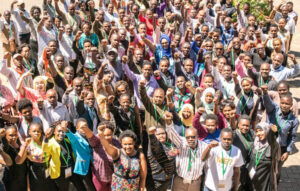What exactly is flexible funding? And how is it different from traditional grantmaking? Our vice president for programs, David Mattingly, has the answers.

Here at the Fund for Global Human Rights, we talk a lot about flexible funding. It’s central to our grantmaking, our mission, our relationships with grantees, and our approach to human rights support.
But what does flexible funding actually mean? What makes it different from other types of grantmaking? And why do we think it’s so critical for grassroots activists especially?
To learn more, we turned to the experts. First, we asked the Fund’s vice president for programs, David Mattingly, who has spent more than 15 years funding grassoots activism around the world, to explain the ins and outs of general operating support. Then, we asked frontline human rights defenders themselves why flexible funding is so important to their work.
Here’s what they said.
What is flexible funding?
In grantmaking, there are two main types of funding. The first is restricted funding—that’s money that is restricted to a specific project or set of activities. The second is flexible funding, which is also known as general operating support. That money goes into the recipient’s overall budget—no strings attached.
When an organization receives flexible funding, it can use those resources for whatever is necessary to achieve its mission—anything from covering a project not supported by other donors, to responding to an unforeseen crisis or opportunity, to even covering basic costs like office rent and staff salaries.
Ultimately, flexible funding is about trust and power: trust that those directly involved in the struggle for human rights know best how to deploy resources to win, and power to make those decisions in real time based on community needs instead of negotiating the details with donors.
What makes flexible funding different from traditional funding?
Flexible funding is an investment based on trust. It implies that frontline activists, who must stay especially agile amid constantly shifting circumstances, know best how to use their resources—which is true!
Traditional, project-based grants can only be used for specific areas of work or types of expenses. These project grants can be a useful way to align donor interests with a group’s activities. But funders and international organizations sometimes use restricted funding to control frontline organizations and compel them to meet the donor’s demands.
Project grants also often exclude spending on core costs, such as salaries or infrastructure. But these expenses are a necessary part of running an organization. Flexible funding can help organizations keep the office lights on or pay staff fair wages.
Flexible funding cedes this decision-making power to the grantee, rather than making the decisions for them. This way, instead of just paying for certain projects, donors can support an organization’s entire mission and theory of change.
How do donors measure the impact of flexible funding?
When organizations receive flexible funding, they report back to donors on their full range of activities, rather than just one project. That gives funders the opportunity to learn more about the organization’s strengths and challenges over time, so they can facilitate additional support as needed.
To assess the impact of flexible grants, funders look at the full story of the group’s activities: how they’ve contributed to the improvement of human rights, how they’ve worked within an ecosystem of groups tackling problems from different perspectives and with different tools, and how they’ve strengthened their own organization and ways of working.
This kind of wide-lens assessment can help the group—and its funders—better understand their full and unique contribution to human rights work. With that information, we can do a better job meeting their needs.
Who does flexible funding help?
Flexible funding can be transformative for small, community-based organizations that have little access to big donors.
These grassroots organizations often only receive funding from one or two sources. General operating support enables them to experiment, learn, and implement their full range of strategies and activities.
But larger groups and movements can also benefit from flexible core funding.
Organizations with many projects and activities spend an incredible amount of valuable time and resources securing project funds for their various areas of work. Not only does this take time, it also means that activities could abruptly end if they’re not able to find more funding after a grant expires. Additionally, employment contracts are often tied explicitly to a certain grant. If that grant ends, there might not be sufficient funding to keep paying that team member—disrupting both the work and that person’s livelihood.
Flexible funding helps these organizations fill the gaps between project grants.
What does flexible funding look like in action?
Flexible funding can be transformative for a grassroots organization because it enables it to meet the moment. Here’s two recent examples from Fund grantees.
The Organizacion Fraternal Negra Hondurena, or OFRANEH, is a social movement of Afro-Indigenous Garifuna communities in Honduras. They provide everything from pro-bono legal services to communal meals. But Honduras is one of the most dangerous countries in the world for human rights activists. Corrupt officials and corporate interests have colluded to steal Garifuna land for exploitative development projects. When OFRANEH stands up for their rights, they face tremendous risk of reprisal.
Flexible funding allows OFRANEH to, when necessary, repurpose their budget for security needs. Combined with strategic accompaniment and technical assistance from the Fund, that helps them stay safe as they carry out their critical work.
Security isn’t the only reason that an organization’s needs might change. In early 2020, as the COVID-19 pandemic raged across the world, governments introduced repressive new legislation under the guise of stopping the spread. Overnight, civic space was transformed.
In Nigeria, for example, state security forces committed widespread human rights violations. Fund grantee Spaces for Change used their flexible funding—as well as a rapid-response grant—to monitor government abuses, engage stakeholders, and rally public support for human rights.
How does the Fund offer flexible support to activists?
At the Fund, we combine flexible funding with technical assistance and other types of strategic support, such as training, and opportunities to share learning.
Human rights work requires sustained action, not one-off projects—unfair and discriminatory systems aren’t reformed overnight. That’s why we invest flexible funding in activists, organizations, and movements for the long haul. By building that trust with the activists we support, we can be true allies and meet their needs.
While flexible funding works for many frontline activists, however, it’s not the only tool at our disposal. In the most restrictive contexts, governments prevent groups from receiving grants. That means that flexible funding isn’t possible.
Some frontline activists or organizations don’t have the capacity to manage flexible, renewable grants. That’s why the Fund also awards short-term and project-based support to groups that need it.
Flexible funding is an essential tool, but it’s not a one-size-fits-all approach to activism. Our approach is to provide the greatest level of flexibility in our funding, so that activists—no matter their circumstances—can use our support to help their communities.
Sign up to our newsletter
Add some impact to your inbox.



